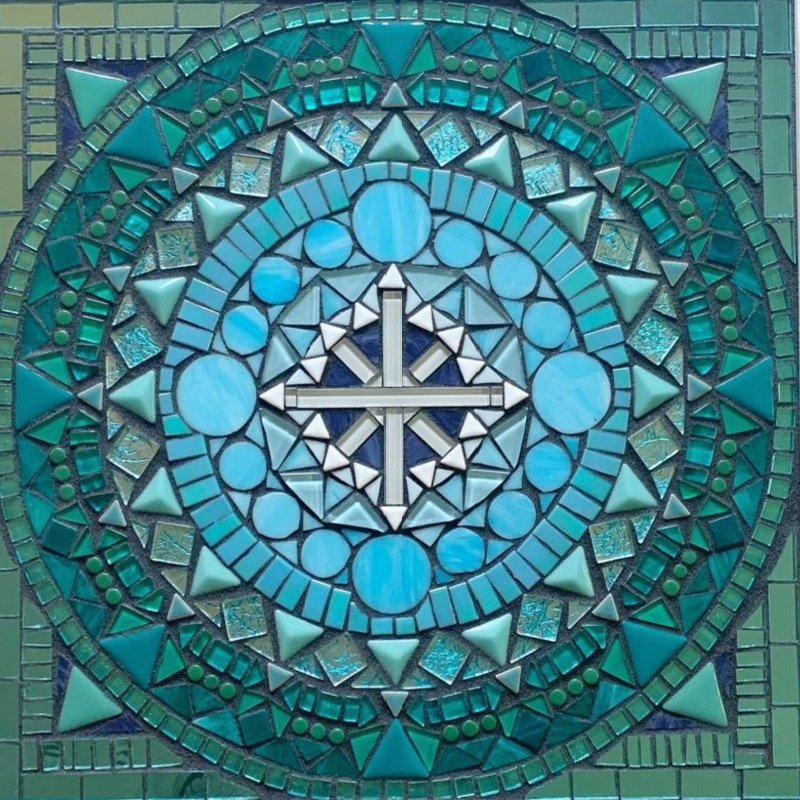I get asked a lot about my process, specifically how long each mandala takes me to make. They are all different and it’s hard to say exactly how long each one takes, so I felt called to outline my mosaic mandala process for those wanting to understand and support my work.
The healing power of a mandala is vast. The mandalas I create are a spell of healing intentions – a potion where each piece must be the exact right fit. I never know what they will become when I start. I simply see the vision and let the medicine work it’s magic through me.
How It All Started
I started mosaic-ing as a result of a project I was assigned for my initiation as a Medicine Woman. Each woman in our circle was asked to make a medicine shield as a representation of our journey over 13 months through the 13 Divine Feminie Principles. After some contemplation, I knew the medium in which I wanted to create my shield, mosaic.
A friend of mine who owns an art gallery as a metal sculpturist (large and small) also dabbled in mosaics. I reached out to her and she was more than willing to guide me on this project. Within a week I was ordering my first batch of tiles and my very first mosaic was birthed. I was hooked. I had so many ideas of what I wanted to create and something inside of me was LITE up. I hadn’t felt this giddy about anything since I started my own business as a fitness coach back in 2012.
It has been only 18 months since I first was introduced to mosaic, but in that short time I have built a home studio full of tiles and sold over 15k in art. When my heart knows the path, there really is nothing in my way. I am in fact a manifesting generator with Venus on my Ascendent in the first house – an auspicious placement for an artist. I believe it is my destiny and I believe mosaic has been my medium for many past lives. My mosaic process has of course transformed in this short time and I believe it will continue to over the years to come. I will be forever grateful for Angela’s mentorship and guidance on this path.
Step 1: Set Up
My tile room is organized by color, so it’s easy for me to go pick a selection of tiles that call to me for a piece. For my circle mandalas, I am currently using MDF board as the substrate. I have created templates for each size I have (6,8,10,12,14,16,18,20,22 inches) with lines and circles to guide me in keeping my design symmetrical. For my square mandalas and samdalas, I use similar square templates in the size of 12 and 16 inches. I cut a piece of sticky mesh the size of the circle or square I am using to prep the substrate. The sticky mesh is great because it keeps the tiles in place, yet impermanent.
Step 2 : Design
I feel very called to color gradients, so whenever I start a new design, I always have a color gradient in mind. I pull a handful of tiles from the shelves and get to work. Depending on my vision, sometimes I start with the centerpiece, sometimes I start with a specific tile or layer within the mandala that is calling to me. My first goal in the design process is to lay out every layer of the mandala, but only as an 1/8th of 1/16th of the full mandala. Here are a few examples.
During this process I have to think ahead to my grout color because grout changes a piece and you have to always keep it in mind or else you will not be satisfied with the end result. I have learned that wisely choosing grout color comes from experience and lots of mistakes.
Once I feel good about how the tiles and colors are interacting with each other, I start to lay out the tiles fully, layer by layer. I often use a measuring tape here on my bigger pieces just to make sure my circles are symmetrical. Even with the lines on my template substrate, each layer can easily get off by 1/8th inch and that does affect the spacing and grout lines. This part of the process is often mindless as the design is already complete. At some point during this process, I may realize that a layer is not quite right and I may decide to make a change. It’s amazing how tiles change when there are many of them vs. just a few. Here is an example.
Once the design is complete, I let it sit in my studio for a couple days (sometimes much longer) and allow the design to marinate. To me, the mandalas are a potent potion of healing intentions and they have to be just right. I do not like to rush this process. I know when they are complete and ready for the next step. If there is any doubt, they stay here waiting.
Step 3: Secure
The tile must be adhered to the substrate before grout. I like to use thin set mortar for this process. I prep the substrate (same size as my template) with a layer of thin set, using a scraper to make sure the layer is even. I do not want too much mortar here or else I have a mess. I need enough to hold the tiles securely but not too much that it oozes above the tile line. I need that space for the grout.
Once my layer of thin set is ready, I carefully pull the sticky mesh with tile from the template onto the prepared substrate. I do my best to line it up with the edges of the substrate, but oftentimes need to use a picker tool to adjust and make micro movements to the mesh. Once the mesh is in place, I start to carefully push down the tiles and set them into the mortar. At this point, I have about 45 minutes before the mortar starts to harden and must carefully look over the design and make sure all tiles are where they need to be. Here is an example. The thin set needs a minimum of 24 hours to fully set before grout, 72 would be best.
Step 4: Grout
Grout changes everything. It will eat the color of your tile for breakfast, lunch and dinner especially if there is too much space for grout. When designing the mandala, I have to take into account what grout color I will be using. A dark grout will hide the dark tiles and very clearly show the light tiles and vice versa. Through my experience and many mistakes, I have learned how I like my grout. I prefer the grout lines to be small (in most cases) and for the grout color to be similar to the outermost ring of the mandala as I find it helps expand the piece. Grout color is easier to choose when you have the same color throughout your piece. Still, I will continue to get the grout color wrong and ruin pieces, it is part of my constant need to experiment and learn.
What I love most about grout is it’s capacity for sculpting. Whenever I use tiles or stones that are of different heights, I must take more time with the grout and sculpt it. The grouting process is done over many hours and layers of cleaning with a rag or sponge. If you have ever tiled a room in your house, you know how this process goes. Here is an example.
Step 5: Finish
This is where I paint the back side of my mandala either white or black, add hardware for hanging and sign my piece. Here is an example. I then must name and price the piece, list it on my website or deliver it to a gallery.
Final Thoughts
I tend to work in batches within these steps. I will spend a week designing mandalas so there is a batch ready to go through the different steps. I secure them all at the same time, spend an entire day grouting them and then finish them all together. For me, that feels more efficient and effective and keeps me from burning out on one particular piece. I also do my best to record the process with video and share those to social media as a way to attract new supporters and collectors of my work. If you are a collector, thank you. If you are a follower and supporter, thank you. If you are a gallery owner who shows my work, thank you.




0 Comments